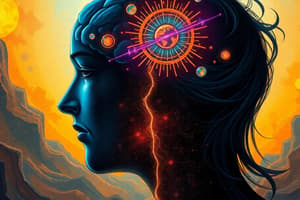Podcast
Questions and Answers
How do implicit and explicit attitudes differ?
How do implicit and explicit attitudes differ?
- Explicit attitudes are produced by the affective component only.
- Explicit attitudes are a joint product of affective, cognitive, and behavioral components. (correct)
- Implicit attitudes are activated automatically from memory. (correct)
- Implicit attitudes are consciously held.
What is an implicit attitude?
What is an implicit attitude?
An attitude that is activated automatically from memory, often without awareness.
What defines an explicit attitude?
What defines an explicit attitude?
A consciously held attitude that involves thoughtful evaluation.
What does the Implicit Association Test (IAT) measure?
What does the Implicit Association Test (IAT) measure?
What is a reference group?
What is a reference group?
What are dual attitudes?
What are dual attitudes?
What are mere exposure effects?
What are mere exposure effects?
What is classical conditioning?
What is classical conditioning?
What is subliminal conditioning?
What is subliminal conditioning?
What is operant conditioning?
What is operant conditioning?
What does cognitive dissonance theory state?
What does cognitive dissonance theory state?
What is dissonance reduction?
What is dissonance reduction?
What is self-perception theory?
What is self-perception theory?
What does the theory of planned behavior suggest?
What does the theory of planned behavior suggest?
Flashcards are hidden until you start studying
Study Notes
Attitude Types
- Implicit attitudes are formed automatically and unconsciously, primarily tied to the affective component of attitudes.
- Explicit attitudes involve conscious thought and deliberation, integrating affective, cognitive, and behavioral components.
Implicit Association Test (IAT)
- The IAT gauges implicit attitudes by analyzing memory associations between different categories, such as animals (dogs, cats) and evaluative terms (like, dislike).
Reference Groups
- Reference groups serve as benchmarks for individuals to assess their own beliefs, behaviors, and attitudes against societal standards.
Dual Attitudes
- Dual attitudes indicate the simultaneous existence of conflicting implicit and explicit attitudes toward the same object or individual.
Mere Exposure Effects
- Repeated exposure to an object can lead to an increase in positive attitudes towards that object, based on familiarity reducing perceived danger.
Classical Conditioning
- Involves associating a neutral stimulus with an unconditioned stimulus to elicit a conditioned response, demonstrating how attitudes can be learned through pairing.
Subliminal Conditioning
- Attitudes can be conditioned without conscious awareness, indicating that classical conditioning can take place below the threshold of consciousness.
Operant Conditioning
- Actions are likely to be repeated if rewarded and less likely if punished, highlighting how behavior is shaped by consequences.
Cognitive Dissonance Theory
- When individuals hold contradictory beliefs, the resulting discomfort motivates them to alter their attitudes to achieve harmony.
Dissonance Reduction
- Cognitive consistency drives individuals to organize their beliefs and attitudes in a way that minimizes discomfort caused by dissonance.
Self-Perception Theory
- Suggests that individuals derive their attitudes from their behaviors, positing that behavior, rather than pre-existing attitudes, informs self-perception.
Theory of Planned Behavior
- This theory asserts that attitudes can forecast deliberate behaviors. However, the decision to act also involves subjective norms and perceived behavioral control, making simple attitude-behavior predictions complex.
Studying That Suits You
Use AI to generate personalized quizzes and flashcards to suit your learning preferences.




